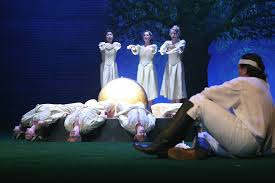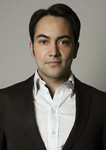Americans on the constant search in Europe not to see other Americans need only go to Detmold, a city of around 70,000 in upper northern Germany about an hour from Hannover and three hours from Berlin. As the major city in a small pre-World War I principality, it is a charming German city, never bombed as it was not strategically important and little changed from times gone by. Traffic is light, and there are more than a few walking only streets in the town’s center. The silence on weekend nights and mornings cannot be found in my experience in other European or American cities. No one is there; the town is literally asleep.
Yet opera flourishes. The theater seats appropriately 650, has excellent acoustics, and was built in the late 1890s. The stage is only 8 cm wide, about a third of the width of the Seattle Opera’s or the Met’s stage, and doesn’t have great depth, but the orchestra pit is both largely under the stage and looks big enough to hold a Wagner-sized orchestra. In German terms it is called C house, which of course relates to the budget and other considerations about which I know nothing. Yet in 2009 under its Intendant, Kay Metzger, it mounted what in photographs appears to have been a very interesting Ring production, sold it well, repeated it in the next season, and won very good reviews. There is apparently a version of the Ring with reduced orchestra that was used. Hearing only two or three minutes of the sound, it sounded light, but the basic Ring could clearly be heard.
I had never before seen opera in a Class C house, and I went to the opening of the season L’elisir d’Amore with great curiosity. It was an excellent performance, much more lively, satisfying, and even echt than recent performances I have attended of this opera in Vienna or at the Metropolitan. The feeling of freshness, good rehearsal, and a desire to produce something worthy of Donizetti pervaded every moment.
Christian Poewe’s production, new last June, placed the opera in a circus locale with Nemorino seeking Adina in the midst of lots of clowns and other circus performers. The two principals, plus Belcore and his two soldiers (!) were the only non-circus members. My favorite was what appeared to be an old vaudeville trick that still works: two women in a double dress, appearing to be Siamese twins. When one drank, the other became furious. Each reacted to what the other did in different ways. All sorts of unexpected events happened, including Adina’s reading about Isolde’s love potion on a chair that descended from the flies. Dulcamara had only one woman in his retinue, a very pretty sort of belly dancer, and wore a magician’s cape. The action of the opera followed the libretto. The experience of watching the artists almost as though one was in a rehearsal room, because of the stage’s proximity to the seats in the orchestra, made me think of what it must have been felt like when this opera and many others were first performed.
The big news of the performance to me came from the major character, Nemorino. A young Chilean tenor, Carlos Moreno Pelizari, created as believable a Nemorino as I can remember. A full-voiced lyric tenor, Pelizari sang the whole role with ease, offering an “Una furtiva lagrima” that couldn’t be bettered anywhere. His ample voice, even throughout the range, and his grasp of the fioritura very much impressed me. I know the theater is small, but I have been hearing auditions in many small spaces for many years. This man has a voice and a real career ahead of him. I was delighted to have such an experience.
Others in the cast were good, with the best singing coming from the Belcore, Beoung Kyu Jeon, still a student at the Hochschuele fuer Musik in Detmold. Katharina Ajyba was Adina, and Michael MacKinnon, Dr. Dulcamara.
Matthias Wegele conducted with lively precision and a very good Italianate feel. It was spirited and exciting Donizetti.
Also in Detmold I had a chance to visit the Hoechschuele for Musik, originally a Palace. The rooms are large and bright with lots of windows looking out on great natural beauty—grass and trees. I went through a large number of practice rooms in the main building set up for pianists and wind instruments as well as some large rooms that would be good for voices. There are apparently other buildings for string, brass, and percussion students. Unfortunately it was summer vacation, but from what I heard of the students at the Elisir, it’s a place that lives up to its reputation in Germany. Students come to if from all over the world, with many presently there from Asia.
One other very operatic aspect of Detmold is the opportunity to visit group of rock formations formed some seventy million years ago. They are tall and rugged. What is most surprising to me about them is how much they don’t fit into the terrain around them. In Utah they would be spectacular but expected. When one climbs the largest the view of the German forest, an anomalous mass of greenery on all sides makes the rocks even more interesting.
Detmold is also known as possibly the place where in 9 AD the Roman invasion of Germany was stopped. A German whose name was Latinate but who was renamed Hermann the German went to Rome and learned how the Roman army worked. He served bravely there, left the army and went back home. When the Romans arrived, he was ready. He knew their method of fighting, turned it on them, and defeated them. Thus was the German language prevented from being one of the Latin languages. No one had paid any attention to this man or the battle until the late nineteenth century, when Otto von Bismarck, the German prime minister, wanted to inspire his countrymen with their early military exploits. He renamed the man Hermann, and commissioned a huge statue honoring him a bit out of Detmold.
The only other item to mention is that in Detmold and in neighboring towns there are an incredible number of houses built and decorated in the 15 and 1600’s. It’s probably the way Nuernberg, for instance, looked prior to World War II. I can’t say the spirit of Hans Sachs is here, but there did occasionally come a hammering sound.






Thank you for a very interesting and perceptive review 🙂
The stage is only 8 cm wide
But surely it is at least wide enough to put your foot on? The average European shoe is a bit wider than 8cm :))
There are 83 full time opera houses in Germany while the USA with four times the population only has one, the Met. And technically, even the Met only has a 7 month season. 47 of the top 100 cities for opera performances per year are in Germany. Austria and Switzerland have a similar density of houses and performances.
I enjoy attending small houses in these countries which usually seat around 500 to 600. As you note, the quality is surprisingly good. The rich opera world in these countries is made possible through public arts funding.
In the USA, philanthropic giving for the arts, culture, and humanities is listed in the 2012 annual report of Giving USA compiled by the Center for Philanthropy at Indiana University. The report stated that that the arts, culture, and humanities receive 4% of total philanthropic giving for a sum of 13 billion. What the arts actually ended up with is not specified (“culture and humanities” includes zoos, boy scouts, swimming pools, parks, and academic research, and so on) but I would estimate that roughly half went to the arts – or $21 per capita. Added to that would be spending for the arts from the Federal, State, and Municipal levels which totals $3.60 per capita. The total for public and private funding for the arts in the USA is thus about $24.60 per capita.
By comparison Austria spends $369 per capita, Denmark $474, Norway $590, Germany $136, Italy $194, and France $265. The average for these countries is $289 – well over ten times American spending, both public and private. The European data is published by The Council of Europe and is available here:
http://www.culturalpolicies.net/web/statistics-funding.php?aid=117&cid=80&lid=en
Even if we add in a large margin of error for these numbers, the average for all arts spending would still be 8 to 10 times higher than in the USA. Some of the European numbers are 5 or 6 years old, but they have not changed considerably. (If anyone tells you the numbers for Europe have changed significantly, demand documentation. You can rest assured that they will not be able to provide it except for a few exceptional cases.)
BTW, little Detmold does more opera performances per year than Los Angeles which has the 3rd largest metro GDP in the world and a metro population of around 15 million. It also does more than our nation’s capital, which has the 11th largest metro GDP in the world. These US cities might have larger halls, but seats sold in relation to population still puts Detmold far ahead. This didn’t happen because Germany is an old and cultured country. It happened because they consciously work to keep opera alive and spend the money to do so.
Good to hear that the German/European model is favored by so many people. I myself had the opportunity to see great presentations in lesser-known cities like Ulm, Kassel, or Giessen. But I also realized that while many people in countries following the sponsor model actually favor the European subsidy concept rarely does anyone mention the financials.
Having lived in Germany and paid taxes helps me appreciate the conscious effort opera companies make here in the US. Here you do find an accountability for the end product and whether or not the audiences (sponsors, subscribers, and the random patron) will actually appreciate the effort. Whereas in parts of Europe it’s either about alienating the audience with weird ideas and provocative staging or trying to be witty without considering the effect to the audience.
I have been to quite some presentation in Germany and throughout Europe where I wouldn’t have missed anything had the company gone out of business prior to my visit: wasteful with resources; unrealistic stage productions that have nothing to do with the plot; use of technology for the sake of using it and not to support the plot; and disrespectful towards the cast by asking too much…
It’s a pity when an opera company struggles to attract subscribers but it is a sign to me that they don’t reach the audience anymore and a change – of program, of stageing, of the way they market their service – needs to happen. This is different for fully subsidized opera companies: they can do anything because they are subsidized and get most of their money from the government (case in point: Bayreuth which has lost the drive of its original founder – unfortunately – and lives off subsidies from the state of Bavaria).
This unaccountable approach may be a wonderful case study of “l’art pour l’art” but it doesn’t help to get new subscribers or engage with the current ones. Precisely because they are not accountable or do not feel accountable, they can follow each and every idea they may have without considering whether it will help to tell the story or bring more subscriber to the house.
According to Operabase, Germany had some 7,230 performances (1st rank; Season 2012/13) vs. 1,730 performances (2nd rank) in the United States. There seems to be a slight chance that more people have already seen an opera in Germany but it remains debatable if the sheer quantity makes them a life-long supporter of opera or whether they have actually seen a thrilling, engaging performance…
Your response is gratifying. I am personally thankful that both countries produce opera very successfully, but having produced opera for 31 years I think that the consideration of the audience is vital. I am glad that for all our problems in America, we cannot just do opera for the sake of doing it. We must consider our audiences. At this particular time I think this is more and more true in Germany. The houses in Germany are in some cases needing sponsors, and the sponsors want them to have audiences. A mix of the two systems, if such an idyllic situation could occur, would be ideal.
I’m afraid I find Stefan’s comment mostly nonsensical. First, the USA ranks 39th in the world for opera performances per capita while Germany ranks 4th. The chances of Germans experiencing live opera are far greater than in the USA.
Second, it’s ridiculous to say that subsidized European houses aren’t accountable to their publics. They are very accountable because when the public becomes dissatisfied the politicians are held accountable for their oversight. Political careers end when cultural policies fails. We thus see that attendance numbers are generally higher in Europe than they are in the States. The Met is not even selling 70% of its seats. LA essentially had to give away many of its Ring tickets. San Diego went bankrupt even though it only did 15 performances per year while Vienna does 300 per year and is 99% sold out. So please, spare us your nonfactual polemic.
There are very clear factors that make subsidized systems better for an expensive art form like opera. First, tickets become affordable. The average ticket prices in Europe are a third to a quarter the cost in the USA. Second, opera houses are nearby which makes it possible for average people to attend them. By contrast, most people in the USA would have to travel hundreds of miles to see a genuinely professional opera performance in a real opera house.
The comments about Regietheater are nonfactual. First, most German productions are about as traditional as they are here in the States. Regietheater productions seem to get more press which creates a false impression in the States. Second, Europeans are much more likely to see operas, so they like to see variation in the productions, including Regietheather. Americans, by contrast, have few opportunities to see an opera, and often will be seeing an opera for the first time. They thus want to see Zerlina milking a cow and all that. The anti-Regietheater sentiments is in some respects a measure of America’s opera parochialism.
As for Mr. Jenkin’s comment about hybrid systems, the results would be negative for continental Europe. The Commonwealth countries used a mixed system and they have far less opera than continental Europeans. As the USA clearly shows, when you rely on rich people to fund the arts, you end up with a few posh institutions in a few financial centers with very expensive tickets while the rest of the country is neglected. These realities stare us in the face. Why do we ignore them?
Mr. Osborne,
I have seen your impressive command of statistics in comments feeds on opera-related blogs across the internet. I’ve noticed you complain about the condition of American opera and after sharing almost entirely accurate data, you challenge us by asking “These realities stare us in the face. Why do we ignore them?”
Let me ask you a non-rhetorical, genuine question: What would you have us do in the United States? Those of us that actually work in these larger houses and fight daily to secure the funding to produce great opera, sell tickets to our communities, engage them with diverse programming, attempt to fill the gap left by dwindling arts education budgets by in-school programming, and create meaningful opera in people’s lives – how do we overturn the system, so to speak? Sure, it would be nice if the US were better ranked in opera performance per capita, but it isn’t. Perhaps we aren’t ignoring the realities, but we are facing difficulties in replacing them with new ones. We deal with the cards we are dealt and make the case for the position of arts in our civilization daily. Would you have us throw up our hands and abandon our posts so the miniscule percentage of philanthropic public and private support that opera represents is channeled to other causes?
My question is not a rhetorical one. I hope you will merit it with a kind response.
I’m also curious to know your source for a great many of your impressive collection of statistics. What group measures statistics like opera performance per capita?
Cordially,
Opus
Hello Opus. It’s late here in Europe but I’ll scribble out an answer before going to bed. Maybe I’ll write more tomorrow. My data comes from the stats section of Operabase which is here:
http://operabase.com/top.cgi?lang=en
To solve our problems we need to move to public funding systems for the arts like all other developed countries have long had. This is close to an impossible task given the narrow political spectrum and dysfunction of the US government even down to municipal levels.
The first steps have to be educational. We need to raise consciousness about how poorly we compare to the rest of the world (as I explain in my posts with stats.) And we need to spread more information about how public funding systems in other countries work and why they are much better. And we need to spread more information about the essential role of arts education in society. This educational process needs to begin with four specific groups:
1. Arts Journalists
2. Artists
3. Music administrators
4. Music educators.
Even these groups are astoundingly ignorant about the comparatively low status of the arts in the USA, and that this problem is caused by our private funding system. Once these four groups are better informed they will pass on information to the larger public. Knowledge lights the darkness and awareness brings change, even if the process is very slow.
We also need to show these four groups that they do not need to feel hopeless. We can remind them that America is capable a great change over time if it is given a firm vision. We can help these four groups gain that vision. And we can help them understand that they need to stick to a long struggle because that is how most meaningful change–like the ongoing American civil rights movement–is created.
One of the specific things the American opera world needs to do is be more objective, honest, and open to dialog about these matters. We shouldn’t, for example, speak of the San Diego Opera as a major company. It only did 15 performances per year while major houses do about 300. When we call it a major company, even by American standards, we are deluding ourselves and not squarely facing the problems we need to solve. We should honestly admit that the number of performances offered by our companies in major cities like Philadelphia, Boston, Atlanta, Washington, and Los Angeles are shockingly low by international standards. Issues such as that we only have 3 cities in the top 100 for opera performances per year should be a major and sustained topic of discussion in the American opera world. We should honestly face and discuss the problems created by using pick-up musicians in rental facilities and compare that to cohesion fulltime companies with dedicated houses have. We should honestly look at the suffering, frustration, and destruction of talent caused when so many of our best young singers have to go to Europe to try to find work. Why aren’t our opera journals addressing these glaring issues on a regular basis?
In short, candid dialog, education about funding systems at home and abroad and how we compare, the improvement of arts education, and the understanding that we must steadfastly engage in a long struggle are the way forward. We might think of ourselves like the visionaries of the Harlem Renaissance in the 1920s who said that someday America would have a black President. People thought they were crazy. Fortunately, those who had hope and a vision prevailed.
I also have other important sources of data. I’ll write again tomorrow.